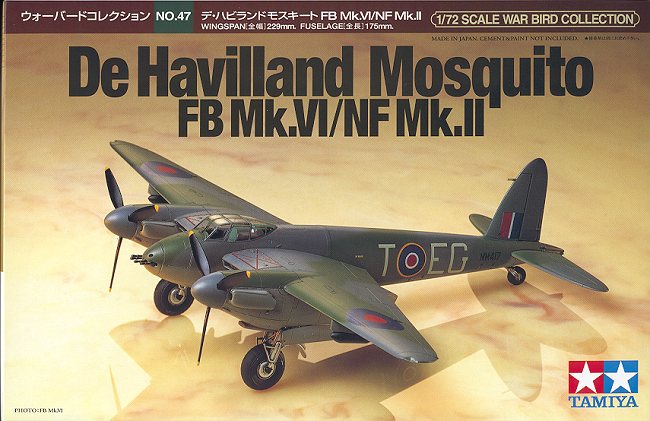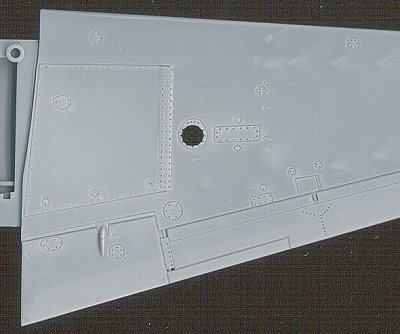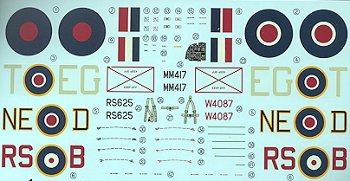
|
KIT: |
Tamiya 1/72 Mosquito FB.VI/NF.II |
|
KIT # |
60747 |
|
PRICE: |
$23.00 (!) |
|
DECALS: |
See review |
|
REVIEW & |
|
|
NOTES: |
|

|
HISTORY |
The development of the DeHavilland Mosquito is a story that is nearly legend. The idea of building a bomber fast enough to outrun defending fighters has always been highly sought. It has also come to pass for a short time on several occasions. Witness the development of the Bristol Blenheim, or the Dornier Do-17, both of which were faster as prototypes than current fighters. However, by the time all the needed operational equipment was installed, that speed had deteriorated or the speed of fighters had increased.
However, the wooden wonder from Hatfield was one bomber which was able to keep the performance edge for a long time. So successful was the Mosquito that it was developed into many different roles including night fighter, anti-shipping, target towing, special ops and a number of others as well as high-speed bombing.
Probably the most used version was the FB.VI (FB for Fighter-bomber). This version was widely used and though the Air Ministry was skeptical about its wooden construction, it proved to be very strong and able to take a lot of damage. Despite the problems in keeping wooden aircraft flying, several are still in the air 60 years after the prototype first flew and many more are in museums world wide.
|
THE KIT |
Probably one of the worst kept secrets is that Tamiya is planning to pantograph down all of its recent 1/48 aircraft to 1/72 scale. This has led to tumultuous cheers from the 1/72 crowd and those kits that have been downsized have proven to be very successful in the market place. It doesn't hurt that they are real beauties when built and engineered just as well as their larger counterparts. This Mosquito kit is no exception.
 First thing you
notice is that there are three poly bags, each with two sprues in it. Now this
is the way that kits should be packaged! Molded in the usual medium dark grey
plastic that Tamiya is well known for, it has lost none of its detailing from
the larger version. Rather than scan all the bits, I have chosen to show just a
small section from the underside of one wing to let you see the detail. This
image is about twice the size of the real part. You can see that nothing has
been lost.
First thing you
notice is that there are three poly bags, each with two sprues in it. Now this
is the way that kits should be packaged! Molded in the usual medium dark grey
plastic that Tamiya is well known for, it has lost none of its detailing from
the larger version. Rather than scan all the bits, I have chosen to show just a
small section from the underside of one wing to let you see the detail. This
image is about twice the size of the real part. You can see that nothing has
been lost.
There are enough bits to make either an NF.II or FB.VI. This includes separate wing tips, the option of shrouded exhaust, different wheel hubs, different instrument panels, different propellers, and different things under wings. For the night fighter, one needs to open the holes near the wing tip for the antenna. For the fighter-bomber, one can have either rockets or bombs under the wings. The rockets (minus the tail fins) are molded onto the rails so displaying just the rails means you have to cut off the rockets. Thankfully, Tamiya has chosen not to pre-open these holes as some other kit makers have done!
The instructions are the complete works that you have come to expect from a premier model company. They are ten folded pages comprising 17 construction steps, each step showing needed paint colors and trim. Naturally all paint call-outs are for Tamiya paints.
 There are three decal options offered for the kit. Each are
labeled as A, B, or C in the construction sequence so you can be sure to get the
right building options to match the proper scheme.
There are three decal options offered for the kit. Each are
labeled as A, B, or C in the construction sequence so you can be sure to get the
right building options to match the proper scheme.
First is a FB.VI of 487 squadron in the standard Dark Green and Ocean Grey over Medium Sea Grey. Next is another FB.VI of 143 Sq. This one is a coastal command unit and is Dark Sea Grey over what is listed as Deck Tan, but I think should be Medium Sea Grey. Finally the NF.II from 157 squadron in overall Matte Black. Any of the three schemes should produce a super kit.
Review copy courtesy of me and my wallet!
If you would like your product reviewed fairly and quickly by a site that has over 900 visits a day, please contact me or see other details in the Note to Contributors.